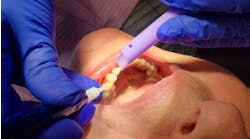By Lorne Lavine, DMD
1. What is your definition of a "paperless practice?"I’ve actually never been a huge fan of the term “paperless practice” as I think it’s extremely difficult, especially for an existing practice, to completely eliminate all paper. Whether it’s insurance forms, walkout statements, patient education brochures, or other documents, removing all paper is very tough. What I do think is achievable, though, and what we’ve done for many practices, is to be completely chartless. This means there is no longer a need for any physical chart or cabinets for those charts. All patient information, charting, documentation, and images can be electronic, so there really is no need to have a chart that can get lost or destroyed.2. What would be the logical first step for a dentist to go paperless?In my lectures, I often suggest a Six Step Plan for going paperless. The steps, in order, are to evaluate 1) practice-management software, 2) image software, 3) operatory design, 4) computers, 5) digital technologies, and finally, 6) data protection. The practice-management software is really the glue that holds everything together, and many of the decisions such as digital X-rays, computers, and data backup will be based on which practice-management software is in place. While there’s no perfect software package out there, there are tons of third-party add-on programs that can help the practice go paperless.3. How long would it take, in your estimation, for an office to go paperless?That depends on where the practice currently is with its technology system, and the comfort level the dentist and staff have with new technologies. In my experience, it’s usually a 12- to 18-month process from the moment a practice decides to go chartless until it achieves that goal. Some practices have done it much quicker, and some we’ve worked with are three years into the process and still on the first step. The key factor here is that you should do things in stages. Choose one system that you want to add, get comfortable with that, and once everyone is at that level of comfort, move on to the next step. There’s no magic bullet ... it has to be thought out in advance, almost like a treatment plan.4. What kind of budget should be set aside for going paperless?As with the previous question, it depends on where the practice is. Many offices look at the costs of the high-tech items such as digital X-rays without realizing that the cost to upgrade their infrastructure is significantly more. For example, most offices spend around $15,000 for digital X-rays, but upgrading the computers and network when all is said and done can be double that amount. If an office already has the infrastructure in place, then the cost to go paperless isn’t all that great since it’s mostly just software programs that are needed. The largest “hidden” cost in all of this is training, as the practice will need multiple days of training as it undergoes the process.5. Is there an ROI for going paperless? If so, how long would it take for it to be realized?I absolutely feel there is a positive ROI, although there doesn’t seem to be any published articles that can really quantify that. Not having to purchase and store paper charts, increased efficiency, greater case acceptance, increased new patient flow, all of these will improve the ROI ... but it’s hard to put exact numbers on that.6. Where does the government's 2014 mandate fit into this?Many practices are unaware that the government is mandating that all patient records, both medical and dental, be electronic by the year 2014. Whether this happens on time is anyone’s guess (look how long it took digital TV to become mandatory), and the 2012 elections could change that. But woe to the practices that don’t do anything to become paperless, that wake up near the end of 2013 and realize they are nowhere near prepared. Another possible incentive is that stimulus money has been put aside for practices that make the switch to paperless. The details have yet to be worked out, but the number I’ve seen from several Web sites is up to $44,000 per practice for offices that go paperless before 2014.7. Do you feel offices understand what needs to be done for 2014?No, I don’t. When I talk to offices about this or talk about it in my lectures, I’m usually met with blank stares. People think this applies only to physicians, but that’s definitely not the case.8. What's the one message you want readers to understand about going paperless?Overall, there are a few key themes here. First, plan it out properly; nobody wants to make a $50,000 mistake. If you want, work with a technology consultant like myself who can help you walk through the steps, but you can certainly get good info on sites like PennWell (http://www.dentistryiq.com/index.html) if you want to do it yourself. Secondly, take the time to get the entire team on board and go at a pace that’s comfortable for everyone. Finally, there’s no time like the present to get started. The deadline of 2014 is closer than you think, and you don’t want to find out the hard way that you shouldn’t have procrastinated.
1. What is your definition of a "paperless practice?"I’ve actually never been a huge fan of the term “paperless practice” as I think it’s extremely difficult, especially for an existing practice, to completely eliminate all paper. Whether it’s insurance forms, walkout statements, patient education brochures, or other documents, removing all paper is very tough. What I do think is achievable, though, and what we’ve done for many practices, is to be completely chartless. This means there is no longer a need for any physical chart or cabinets for those charts. All patient information, charting, documentation, and images can be electronic, so there really is no need to have a chart that can get lost or destroyed.2. What would be the logical first step for a dentist to go paperless?In my lectures, I often suggest a Six Step Plan for going paperless. The steps, in order, are to evaluate 1) practice-management software, 2) image software, 3) operatory design, 4) computers, 5) digital technologies, and finally, 6) data protection. The practice-management software is really the glue that holds everything together, and many of the decisions such as digital X-rays, computers, and data backup will be based on which practice-management software is in place. While there’s no perfect software package out there, there are tons of third-party add-on programs that can help the practice go paperless.3. How long would it take, in your estimation, for an office to go paperless?That depends on where the practice currently is with its technology system, and the comfort level the dentist and staff have with new technologies. In my experience, it’s usually a 12- to 18-month process from the moment a practice decides to go chartless until it achieves that goal. Some practices have done it much quicker, and some we’ve worked with are three years into the process and still on the first step. The key factor here is that you should do things in stages. Choose one system that you want to add, get comfortable with that, and once everyone is at that level of comfort, move on to the next step. There’s no magic bullet ... it has to be thought out in advance, almost like a treatment plan.4. What kind of budget should be set aside for going paperless?As with the previous question, it depends on where the practice is. Many offices look at the costs of the high-tech items such as digital X-rays without realizing that the cost to upgrade their infrastructure is significantly more. For example, most offices spend around $15,000 for digital X-rays, but upgrading the computers and network when all is said and done can be double that amount. If an office already has the infrastructure in place, then the cost to go paperless isn’t all that great since it’s mostly just software programs that are needed. The largest “hidden” cost in all of this is training, as the practice will need multiple days of training as it undergoes the process.5. Is there an ROI for going paperless? If so, how long would it take for it to be realized?I absolutely feel there is a positive ROI, although there doesn’t seem to be any published articles that can really quantify that. Not having to purchase and store paper charts, increased efficiency, greater case acceptance, increased new patient flow, all of these will improve the ROI ... but it’s hard to put exact numbers on that.6. Where does the government's 2014 mandate fit into this?Many practices are unaware that the government is mandating that all patient records, both medical and dental, be electronic by the year 2014. Whether this happens on time is anyone’s guess (look how long it took digital TV to become mandatory), and the 2012 elections could change that. But woe to the practices that don’t do anything to become paperless, that wake up near the end of 2013 and realize they are nowhere near prepared. Another possible incentive is that stimulus money has been put aside for practices that make the switch to paperless. The details have yet to be worked out, but the number I’ve seen from several Web sites is up to $44,000 per practice for offices that go paperless before 2014.7. Do you feel offices understand what needs to be done for 2014?No, I don’t. When I talk to offices about this or talk about it in my lectures, I’m usually met with blank stares. People think this applies only to physicians, but that’s definitely not the case.8. What's the one message you want readers to understand about going paperless?Overall, there are a few key themes here. First, plan it out properly; nobody wants to make a $50,000 mistake. If you want, work with a technology consultant like myself who can help you walk through the steps, but you can certainly get good info on sites like PennWell (http://www.dentistryiq.com/index.html) if you want to do it yourself. Secondly, take the time to get the entire team on board and go at a pace that’s comfortable for everyone. Finally, there’s no time like the present to get started. The deadline of 2014 is closer than you think, and you don’t want to find out the hard way that you shouldn’t have procrastinated.
Lorne Lavine, DMD, practiced periodontics and implant dentistry for more than 10 years. He is an A+ certified computer technician, as well as Network+ certified. He is the president of Dental Technology Consultants, a company that assists dentists in all phases of technology integration in the dental practice. He can be reached by e-mail at [email protected] or by phone at (866) 204-2298. Visit his Web site at www.thedigitaldentist.com.







